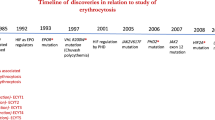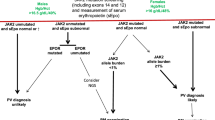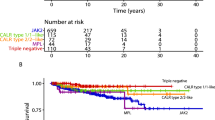Abstract
My diagnostic approach in case of isolated erythrocytosis is based on the visit and the interview of patients, and on checking the causes of secondary erythrocytosis. If causes of secondary erythrocytosis are not evident and serum erythropoietin level is low–normal, I study JAK2 mutations. In the case of a patient with erythrocytosis and other signs of myeloproliferation, such as leukocytosis, thrombocytosis or splenomegaly, the diagnosis of polycythemia vera (PV) is likely, and I test serum erythropoietin and JAK2 mutations first. I stratify patients at diagnosis of PV according to age and history of thrombosis. I start hydroxyurea for patients who are at a high risk of thrombosis (that is, with one or two risk factors), while I continue only phlebotomy in other cases. All PV patients, if not contraindicated, receive aspirin. I follow up patients monthly until normalization of their blood cell counts or splenomegaly, and afterwards every 2 months with visit, cell blood count and blood smear evaluation. After diagnosis, I perform bone marrow biopsy only in the case of clinical signs of disease evolution.
This is a preview of subscription content, access via your institution
Access options
Subscribe to this journal
Receive 12 print issues and online access
$259.00 per year
only $21.58 per issue
Buy this article
- Purchase on Springer Link
- Instant access to full article PDF
Prices may be subject to local taxes which are calculated during checkout
Similar content being viewed by others
References
Passamonti F, Rumi E, Caramella M, Elena C, Arcaini L, Boveri E et al. A dynamic prognostic model to predict survival in post-polycythemia vera myelofibrosis. Blood 2008; 111: 3383–3387.
Kralovics R, Passamonti F, Buser AS, Teo SS, Tiedt R, Passweg JR et al. A gain-of-function mutation of JAK2 in myeloproliferative disorders. N Engl J Med 2005; 352: 1779–1790.
Scott LM, Tong W, Levine RL, Scott MA, Beer PA, Stratton MR et al. JAK2 exon 12 mutations in polycythemia vera and idiopathic erythrocytosis. N Engl J Med 2007; 356: 459–468.
Passamonti F, Elena C, Schnittger S, Skoda RC, Green AR, Girodon F et al. Molecular and clinical features of the myeloproliferative neoplasm associated with JAK2 exon 12 mutations. Blood 2011; 117: 2813–2816.
Lasho TL, Pardanani A, Tefferi A . LNK mutations in JAK2 mutation-negative erythrocytosis. N Engl J Med 2010; 363: 1189–1190.
Delhommeau F, Dupont S, Della Valle V, James C, Trannoy S, Masse A et al. Mutation in TET2 in myeloid cancers. N Engl J Med 2009; 360: 2289–2301.
Rumi E, Elena C, Passamonti F . Mutational status of myeloproliferative neoplasms. Crit Rev Eukaryot Gene Expr 2010; 20: 61–76.
Passamonti F, Maffioli M, Caramazza D, Cazzola M . Myeloproliferative neoplasms: from JAK2 mutations discovery to JAK2 inhibitor therapies. Oncotarget 2011; 2: 485–490.
Tefferi A, Thiele J, Orazi A, Kvasnicka HM, Barbui T, Hanson CA et al. Proposals and rationale for revision of the World Health Organization diagnostic criteria for polycythemia vera, essential thrombocythemia, and primary myelofibrosis: recommendations from an ad hoc international expert panel. Blood 2007; 110: 1092–1097.
Barbui T, Barosi G, Birgegard G, Cervantes F, Finazzi G, Griesshammer M et al. Philadelphia-negative classical myeloproliferative neoplasms: critical concepts and management recommendations from European LeukemiaNet. J Clin Oncol 2011; 29: 761–770.
Semenza GL . Hypoxia-inducible factor 1: control of oxygen homeostasis in health and disease. Pediatr Res 2001; 49: 614–617.
Semenza GL, Wang GL . A nuclear factor induced by hypoxia via de novo protein synthesis binds to the human erythropoietin gene enhancer at a site required for transcriptional activation. Mol Cell Biol 1992; 12: 5447–5454.
Ang SO, Chen H, Hirota K, Gordeuk VR, Jelinek J, Guan Y et al. Disruption of oxygen homeostasis underlies congenital Chuvash polycythemia. Nat Genet 2002; 32: 614–621.
Percy MJ, Rumi E . Genetic origins and clinical phenotype of familial and acquired erythrocytosis and thrombocytosis. Am J Hematol 2009; 84: 46–54.
Rumi E, Passamonti F, Della Porta MG, Elena C, Arcaini L, Vanelli L et al. Familial chronic myeloproliferative disorders: clinical phenotype and evidence of disease anticipation. J Clin Oncol 2007; 25: 5630–5635.
Passamonti F, Rumi E, Pietra D, Della Porta MG, Boveri E, Pascutto C et al. Relation between JAK2 (V617F) mutation status, granulocyte activation, and constitutive mobilization of CD34+ cells into peripheral blood in myeloproliferative disorders. Blood 2006; 107: 3676–3682.
Tefferi A, Vardiman JW . Classification and diagnosis of myeloproliferative neoplasms: the 2008 World Health Organization criteria and point-of-care diagnostic algorithms. Leukemia 2008; 22: 14–22.
Thiele J, Kvasnicka HM, Facchetti F, Franco V, van der Walt J, Orazi A . European consensus on grading bone marrow fibrosis and assessment of cellularity. Haematologica 2005; 90: 1128–1132.
Gangat N, Strand J, Lasho TL, Finke CM, Knudson RA, Pardanani A et al. Cytogenetic studies at diagnosis in polycythemia vera: clinical and JAK2V617F allele burden correlates. Eur J Haematol 2008; 80: 197–200.
Cervantes F, Passamonti F, Barosi G . Life expectancy and prognostic factors in the classic BCR/ABL-negative myeloproliferative disorders. Leukemia 2008; 22: 905–914.
Marchioli R, Finazzi G, Landolfi R, Kutti J, Gisslinger H, Patrono C et al. Vascular and neoplastic risk in a large cohort of patients with polycythemia vera. J Clin Oncol 2005; 23: 2224–2232.
Lippert E, Girodon F, Hammond E, Jelinek J, Reading NS, Fehse B et al. Concordance of assays designed for the quantification of JAK2V617F: a multicenter study. Haematologica 2009; 94: 38–45.
Passamonti F, Rumi E, Pietra D, Elena C, Boveri E, Arcaini L et al. A prospective study of 338 patients with polycythemia vera: the impact of JAK2 (V617F) allele burden and leukocytosis on fibrotic or leukemic disease transformation and vascular complications. Leukemia 2010; 24: 1574–1579.
Vannucchi AM, Antonioli E, Guglielmelli P, Longo G, Pancrazzi A, Ponziani V et al. Prospective identification of high-risk polycythemia vera patients based on JAK2(V617F) allele burden. Leukemia 2007; 21: 1952–1959.
Passamonti F, Rumi E, Pascutto C, Cazzola M, Lazzarino M . Increase in leukocyte count over time predicts thrombosis in patients with low-risk essential thrombocythemia. J Thromb Haemost 2009; 7: 1587–1589.
Passamonti F, Rumi E, Arcaini L, Boveri E, Elena C, Pietra D et al. Prognostic factors for thrombosis, myelofibrosis, and leukemia in essential thrombocythemia: a study of 605 patients. Haematologica 2008; 93: 1645–1651.
Landolfi R, Di Gennaro L, Barbui T, De Stefano V, Finazzi G, Marfisi R et al. Leukocytosis as a major thrombotic risk factor in patients with polycythemia vera. Blood 2007; 109: 2446–2452.
Caramazza D, Caracciolo C, Barone R, Malato A, Saccullo G, Cigna V et al. Correlation between leukocytosis and thrombosis in Philadelphia-negative chronic myeloproliferative neoplasms. Ann Hematol 2009; 88: 967–971.
Gangat N, Wolanskyj AP, Schwager SM, Hanson CA, Tefferi A . Leukocytosis at diagnosis and the risk of subsequent thrombosis in patients with low-risk essential thrombocythemia and polycythemia vera. Cancer 2009; 115: 5740–5745.
Passamonti F, Rumi E, Arcaini L, Castagnola C, Lunghi M, Bernasconi P et al. Leukemic transformation of polycythemia vera: a single center study of 23 patients. Cancer 2005; 104: 1032–1036.
Passamonti F, Rumi E, Arcaini L, Elena C, Castagnola C, Zappasodi P et al. Blast phase of essential thrombocythemia: a single center study. Am J Hematol 2009; 84: 641–644.
Passamonti F, Rumi E, Pungolino E, Malabarba L, Bertazzoni P, Valentini M et al. Life expectancy and prognostic factors for survival in patients with polycythemia vera and essential thrombocythemia. Am J Med 2004; 117: 755–761.
Gangat N, Strand J, Li CY, Wu W, Pardanani A, Tefferi A . Leucocytosis in polycythaemia vera predicts both inferior survival and leukaemic transformation. Br J Haematol 2007; 138: 354–358.
Finazzi G, Caruso V, Marchioli R, Capnist G, Chisesi T, Finelli C et al. Acute leukemia in polycythemia vera: an analysis of 1638 patients enrolled in a prospective observational study. Blood 2005; 105: 2664–2670.
Najean Y, Rain JD . Treatment of polycythemia vera: the use of hydroxyurea and pipobroman in 292 patients under the age of 65 years. Blood 1997; 90: 3370–3377.
Najean Y, Rain JD . Treatment of polycythemia vera: use of 32P alone or in combination with maintenance therapy using hydroxyurea in 461 patients greater than 65 years of age. The French Polycythemia Study Group. Blood 1997; 89: 2319–2327.
Cortelazzo S, Finazzi G, Ruggeri M, Vestri O, Galli M, Rodeghiero F et al. Hydroxyurea for patients with essential thrombocythemia and a high risk of thrombosis. N Engl J Med 1995; 332: 1132–1136.
Harrison CN, Campbell PJ, Buck G, Wheatley K, East CL, Bareford D et al. Hydroxyurea compared with anagrelide in high-risk essential thrombocythemia. N Engl J Med 2005; 353: 33–45.
Passamonti F, Randi ML, Rumi E, Pungolino E, Elena C, Pietra D et al. Increased risk of pregnancy complications in patients with essential thrombocythemia carrying the JAK2 (617V>F) mutation. Blood 2007; 110: 485–489.
Tefferi A, Passamonti F . Essential thrombocythemia and pregnancy: observations from recent studies and management recommendations. Am J Hematol 2009; 84: 629–630.
Passamonti F, Rumi E, Randi ML, Morra E, Cazzola M . Aspirin in pregnant patients with essential thrombocythemia: a retrospective analysis of 129 pregnancies. J Thromb Haemost 2010; 8: 411–413.
Kiladjian JJ, Cassinat B, Chevret S, Turlure P, Cambier N, Roussel M et al. Pegylated interferon-alfa-2a induces complete hematologic and molecular responses with low toxicity in polycythemia vera. Blood 2008; 112: 3065–3072.
Quintas-Cardama A, Kantarjian H, Manshouri T, Luthra R, Estrov Z, Pierce S et al. Pegylated interferon alfa-2a yields high rates of hematologic and molecular response in patients with advanced essential thrombocythemia and polycythemia vera. J Clin Oncol 2009; 27: 5418–5424.
Passamonti F, Malabarba L, Orlandi E, Barate C, Canevari A, Brusamolino E et al. Polycythemia vera in young patients: a study on the long-term risk of thrombosis, myelofibrosis and leukemia. Haematologica 2003; 88: 13–18.
Passamonti F, Brusamolino E, Lazzarino M, Barate C, Klersy C, Orlandi E et al. Efficacy of pipobroman in the treatment of polycythemia vera: long-term results in 163 patients. Haematologica 2000; 85: 1011–1018.
Bjorkholm M, Derolf AR, Hultcrantz M, Kristinsson SY, Ekstrand C, Goldin LR et al. Treatment-related risk factors for transformation to acute myeloid leukemia and myelodysplastic syndromes in myeloproliferative neoplasms. J Clin Oncol 2011; 29: 2410–2415.
Mesa RA, Verstovsek S, Cervantes F, Barosi G, Reilly JT, Dupriez B et al. Primary myelofibrosis (PMF), post polycythemia vera myelofibrosis (post-PV MF), post essential thrombocythemia myelofibrosis (post-ET MF), blast phase PMF (PMF-BP): consensus on terminology by the international working group for myelofibrosis research and treatment (IWG-MRT). Leuk Res 2007; 31: 737–740.
Barosi G, Mesa RA, Thiele J, Cervantes F, Campbell PJ, Verstovsek S et al. Proposed criteria for the diagnosis of post-polycythemia vera and post-essential thrombocythemia myelofibrosis: a consensus statement from the International Working Group for Myelofibrosis Research and Treatment. Leukemia 2008; 22: 437–438.
Cervantes F, Dupriez B, Pereira A, Passamonti F, Reilly JT, Morra E et al. New prognostic scoring system for primary myelofibrosis based on a study of the International Working Group for Myelofibrosis Research and Treatment. Blood 2009; 113: 2895–2901.
Passamonti F, Cervantes F, Vannucchi AM, Morra E, Rumi E, Pereira A et al. A dynamic prognostic model to predict survival in primary myelofibrosis: a study by the IWG-MRT (International Working Group for Myeloproliferative Neoplasms Research and Treatment). Blood 2010; 115: 1703–1708.
Passamonti F, Cervantes F, Vannucchi AM, Morra E, Rumi E, Cazzola M et al. Dynamic International Prognostic Scoring System (DIPSS) predicts progression to acute myeloid leukemia in primary myelofibrosis. Blood 2010; 116: 2857–2858.
Gangat N, Caramazza D, Vaidya R, George G, Begna K, Schwager S et al. DIPSS plus: a refined Dynamic International Prognostic Scoring System for primary myelofibrosis that incorporates prognostic information from karyotype, platelet count, and transfusion status. J Clin Oncol 2011; 29: 392–397.
Stewart WA, Pearce R, Kirkland KE, Bloor A, Thomson K, Apperley J et al. The role of allogeneic SCT in primary myelofibrosis: a British Society for Blood and Marrow Transplantation study. Bone Marrow Transplant 2010; 45: 1587–1593.
Ballen KK, Shrestha S, Sobocinski KA, Zhang MJ, Bashey A, Bolwell BJ et al. Outcome of transplantation for myelofibrosis. Biol Blood Marrow Transplant 2010; 16: 358–367.
Alchalby H, Badbaran A, Zabelina T, Kobbe G, Hahn J, Wolff D et al. Impact of JAK2V617F mutation status, allele burden, and clearance after allogeneic stem cell transplantation for myelofibrosis. Blood 2010; 116: 3572–3581.
Kroger N, Holler E, Kobbe G, Bornhauser M, Schwerdtfeger R, Baurmann H et al. Allogeneic stem cell transplantation after reduced-intensity conditioning in patients with myelofibrosis: a prospective, multicenter study of the Chronic Leukemia Working Party of the European Group for Blood and Marrow Transplantation. Blood 2009; 114: 5264–5270.
Patriarca F, Bacigalupo A, Sperotto A, Isola M, Bruno B, van Lint MT et al. Outcome of allogeneic stem cell transplantation following reduced-intensity conditioning regimen in patients with idiopathic myelofibrosis: the g.I.T.m.o. experience. Mediterr J Hematol Infect Dis 2010; 2: e2010010.
Sorror ML, Maris MB, Storb R, Baron F, Sandmaier BM, Maloney DG et al. Hematopoietic cell transplantation (HCT)-specific comorbidity index: a new tool for risk assessment before allogeneic HCT. Blood 2005; 106: 2912–2919.
Mesa RA, Steensma DP, Pardanani A, Li CY, Elliott M, Kaufmann SH et al. A phase 2 trial of combination low-dose thalidomide and prednisone for the treatment of myelofibrosis with myeloid metaplasia. Blood 2003; 101: 2534–2541.
Marchetti M, Barosi G, Balestri F, Viarengo G, Gentili S, Barulli S et al. Low-dose thalidomide ameliorates cytopenias and splenomegaly in myelofibrosis with myeloid metaplasia: a phase II trial. J Clin Oncol 2004; 22: 424–431.
Cervantes F, Alvarez-Larran A, Hernandez-Boluda JC, Sureda A, Torrebadell M, Montserrat E . Erythropoietin treatment of the anaemia of myelofibrosis with myeloid metaplasia: results in 20 patients and review of the literature. Br J Haematol 2004; 127: 399–403.
Tefferi A, Verstovsek S, Barosi G, Passamonti F, Roboz GJ, Gisslinger H et al. Pomalidomide is active in the treatment of anemia associated with myelofibrosis. J Clin Oncol 2009; 27: 4563–4569.
Verstovsek S, Kantarjian H, Mesa RA, Pardanani AD, Cortes-Franco J, Thomas DA et al. Safety and efficacy of INCB018424, a JAK1 and JAK2 inhibitor, in myelofibrosis. N Engl J Med 2010; 363: 1117–1127.
Pardanani A, Gotlib JR, Jamieson C, Cortes JE, Talpaz M, Stone RM et al. Safety and efficacy of TG101348, a selective JAK2 inhibitor, in myelofibrosis. J Clin Oncol 2011; 29: 789–796.
Author information
Authors and Affiliations
Corresponding author
Ethics declarations
Competing interests
The author declares no conflict of interest.
Rights and permissions
About this article
Cite this article
Passamonti, F. How to manage polycythemia vera. Leukemia 26, 870–874 (2012). https://doi.org/10.1038/leu.2011.334
Received:
Accepted:
Published:
Issue Date:
DOI: https://doi.org/10.1038/leu.2011.334
Keywords
This article is cited by
-
Is there a gender effect in polycythemia vera?
Annals of Hematology (2021)



